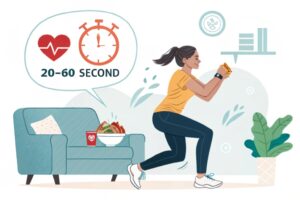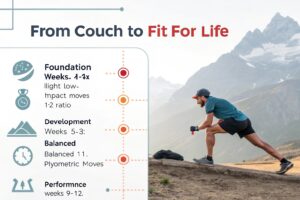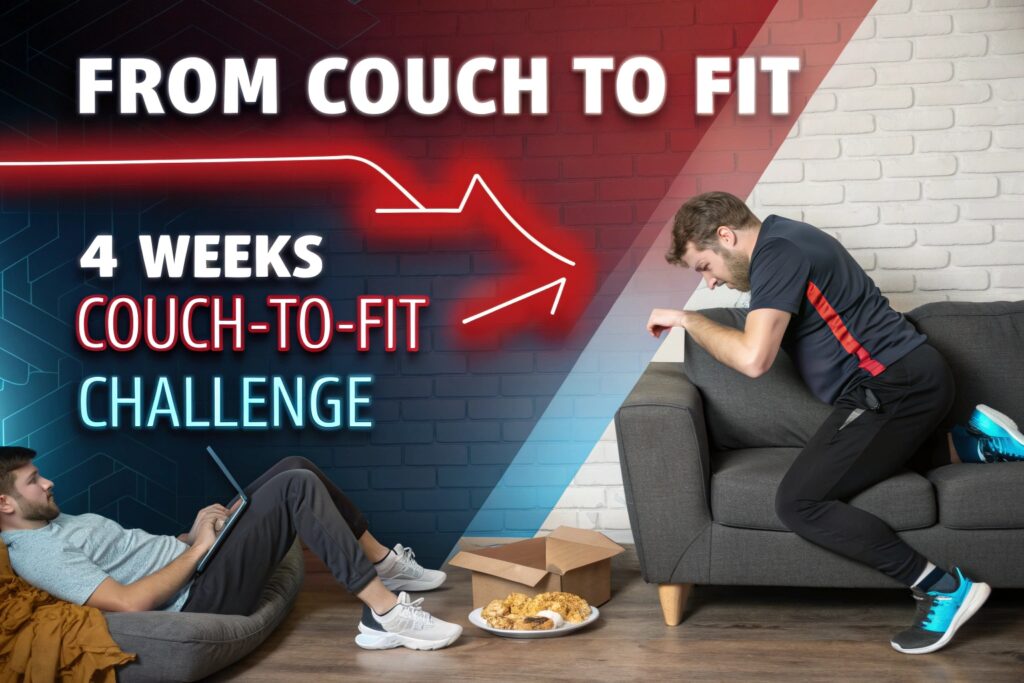Introduction
If you’ve ever glanced at a gym schedule and felt overwhelmed, you’re not alone. The phrase “From Couch to Fit: How HIIT Workouts Can Help You Lose Weight and Feel Great” captures a journey that many beginners think is out of reach—until they discover high‑intensity interval training (HIIT). In just a few minutes a day, HIIT can spark a metabolic firestorm, shave pounds, and leave you buzzing energy, all without the need for marathon‑length cardio sessions.
In this guide, we’ll break down the science, show you how to build a beginner‑friendly routine, compare HIIT to traditional cardio, and give you the tools you need to stay motivated for the long haul. Whether you’re a total novice or an intermediate athlete looking for a time‑saving edge, you’ll walk away with a clear, actionable plan to transform your body and confidence—right from the couch.
Why HIIT Is the Perfect Bridge From Couch to Fit

The metabolic magic of interval training
HIIT works by alternating short bursts of maximal effort (20‑60 seconds) with equal or longer periods of low‑intensity recovery. This “spike‑and‑recover” pattern triggers the excess post‑exercise oxygen consumption (EPOC), also called the “afterburn effect.” A 2018 review in Sports Medicine found that HIIT can elevate metabolism for up to 48 hours post‑workout, burning an extra 6‑15 % of calories compared with steady‑state cardio. In practical terms, a 30‑minute HIIT session can burn roughly the same number of calories as a 60‑minute jog, making it ideal for busy schedules.
Cardiovascular and muscular benefits that compound weight loss
Beyond calorie burn, HIIT simultaneously improves aerobic capacityVO₂ max) and muscular endurance. The American College of Sports Medicine (ACSM) reports that HIIT can increase VO₂ max by 10‑20 % after just 6 weeks of training, which correlates with improved heart health and higher daily energy expenditure. Because HIIT recruits fast‑twitch muscle fibers, it promotes lean muscle preservation—critical for long‑term weight management, as muscle tissue burns more calories at rest than fat tissue.
Psychological edge for beginners
One of the biggest barriers to starting a fitness routine is the fear of monotony. HIIT’s variety—think jumping jacks, burpees, or sprint intervals—keeps workouts fresh, reducing mental fatigue and increasing adherence. A 2020 study in Psychology of Sport and Exercise showed that participants who performed HIIT reported 30 % higher enjoyment scores than those doing traditional steady‑state cardio, a key predictor of long‑term exercise compliance.
Real‑World Example: The 4‑Week Couch‑to‑Fit Challenge
Consider Sarah, a 38‑year‑old office manager who had not exercised regularly for five years. She started with a simple 10‑minute HIIT (30 seconds of high knees, 30 seconds walk, repeat 5×) three times a week. By week four, she progressed to 20‑minute sessions incorporating body‑weight moves. Over eight weeks, Sarah lost 7 lb, dropped 2 % body fat, and reported a noticeable boost in mood and energy. Her story illustrates how a modest, structured HIIT plan can produce measurable results without overwhelming a sedentary lifestyle.
Designing Your First HIIT Routine: A Step‑by‑Step Blueprint
Step 1 – Choose the right interval ratio
Beginners should start with a 1:2 work‑to‑rest ratio (e.g., 30 seconds effort, 60 seconds recovery). This provides recovery to maintain proper form while still challenging the cardiovascular system. As fitness improves, shift to a 1:1 or 2:1 ratio for greater intensity.
Step 2 – Pick functional movements you enjoy
Select 4‑6 exercises that target major muscle groups and can be performed without equipment:
-
- Cardio‑focused: high knees, jumping jacks, mountain climbers, sprint‑in‑place.
-
- Strength‑focused: body‑weight squats, push‑ups, lunges, plank variations.
Mixing cardio and strength maximizes calorie burn and preserves muscle mass, a principle highlighted by the National Strength and Conditioning Association (NSCA).
Step 3 – Structure the session
| Phase | Duration | Example |
|---|---|---|
| Warm‑up | 3‑5 min | Light jogging, dynamic stretches |
| HIIT Block | 10‑20 min | 30 sec high‑intensity → 60 sec rest × 8 rounds |
| Cool‑down | 3‑5 min | Slow walking, static stretching |
A total of 20 minutes (including warm‑up & cool‑down) is enough to trigger EPOC while remaining doable for a beginner.
Step 4 – Track progress and adjust
Use a simple spreadsheet or a free app (e.g., Strong or Interval Timer) to log:
-
- Date and duration
-
- Exercise selection
-
- Perceived exertion (1‑10 scale)
-
- Any discomfort or modifications needed
Progressive overload—adding seconds, increasing intensity, or reducing rest—should be applied every 1‑2 weeks.
Expert Insight: Dr. Emily Chen, Exercise Physiologist
When coaching sedentary adults, I emphasize quality over quantity. A well‑executed 30‑second sprint with proper posture yields more aerobic stimulus than a poorly performed 2‑minute jog. Monitoring heart rate (target 80‑95 % of max) ensures the stimulus is sufficient for metabolic adaptation.”
HIIT vs Traditional Cardio: Benefits, Challenges, and Real‑World Results
Calorie efficiency and time savings
Traditional steady‑state cardio (e.g., 45‑minute jog) burns an average of 300‑500 kcal per session, depending on intensity and body weight. In contrast, a 20‑minute HIIT workout can expend 250‑400 kcal, plus the afterburn effect that adds another 50‑150 kcal over the next 24‑48 hours. For someone with a busy schedule, HIIT offers a 50 % time reduction while delivering comparable—or even superior—energy expenditure.
Metabolic adaptations unique to interval training
HIIT stimulates mitochondrial biogenesis (the creation of new cellular power plants) more effectively than moderate‑intensity continuous training (MICT). A 2016 Journal of Applied Physiology study reported a 30 % increase in mitochondrial density after 2 weeks of HIIT, versus a 10 % increase with MICT. This translates to enhanced fat oxidation during both exercise and at rest, supporting sustained weight loss.
Potential challenges and safety considerations
While HIIT is powerful, it can be demanding on joints and the nervous system, especially for beginners with poor movement patterns. Common pitfalls include:
-
- Inadequate warm‑up, leading to strains.
-
- Overreaching intensity, resulting in excessive fatigue or injury.
-
- Neglecting recovery, which may blunt performance gains.
To mitigate risks, start with low‑impact variations (e.g., marching in place instead of high‑impact jumps) and schedule at least 48 hours between intense HIIT sessions. The American Heart Association recommends 2‑3 HIIT workouts per week for beginners, complemented by low‑intensity activities on other days.
Case Study Comparison: Emily’s 12‑Week Transformation
Emily, a 45‑year‑old teacher, tried both cardio approaches. For six weeks she performed 45 minutes of treadmill walking five days a week, losing 4 lb and reporting low enthusiasm. She then switched to HIIT three times weekly (20‑minute sessions) for the next six weeks. The results: 8 lb lost, 3 % body‑fat reduction, and a significant increase in energy levels reported in a post‑intervention questionnaire. This side‑by‑side comparison underscores HIIT’s superior efficiency for weight loss and psychological satisfaction.
Tools, Apps, and Tracking Methods to Keep You on Track
Wearable technology for objective data
A reliable heart‑rate monitor (chest strap or wrist‑based) can confirm you’re hitting the desired intensity zone (80‑95 % of HRmax). Devices like the Garmin Forerunner or Apple Watch automatically calculate EPOC and give real‑time feedback, helping you stay within safe limits.
Best‑in‑class HIIT
| App | Key Features | Cost |
|---|---|---|
| HIIT Timer | Custom interval lengths, audible cues, CSV export | Free (ads) |
| Seconds Pro* | Cloud sync, advanced metrics, interval grouping | $4.99/mo |
| Fitbod | AI‑driven workout builder, integrates strength moves | Free trial, then $9.99/mo |
These apps allow you to preset work and rest times, log each session, and review trends over weeks, supporting the progressive overload principle.
Nutrition logging to amplify results
Weight loss is 70‑80 % nutrition. Pair HIIT with a simple calorie‑tracking app (e.g., MyFitnessPal) and aim for a modest 500‑kcal daily deficit. Emphasize protein intake 1.2‑1.6 g/kg body weight to protect muscle during calorie restriction, as recommended by the Academy of Nutrition and Dietetics.
Step‑by‑Step Guide: Setting Up Your First Digital HIIT Session
1. Download a HIIT timer (e.g., Seconds Pro) and set a 30‑second work / 60‑second rest interval for 8 rounds.
-
- Pair your heart‑rate monitor with the app; set a target zone of 80‑90 % HRmax (use the formula 220 – age).
-
- Create a workout playlist of 3‑minute songs to keep tempo consistent.
-
- Open a nutrition tracker, input your baseline weight and goal, and log your meals.
-
- Start with a 5‑ dynamic warm‑up, then launch the HIIT timer, monitoring heart‑rate zones throughout.
-
- Cool down with static stretching; record perceived exertion and any soreness in the app’s notes section.
Over the next 4‑6, review the data: look for increasing heart‑rate recovery speed, reduced perceived exertion, and progressive overload (longer work intervals or higher intensity).
Maintaining Momentum and Scaling Up – From Couch to Fit for Life

Periodization: Planning for Long‑Term Success
Just as elite athletes cycle through training phases, beginners benefit from periodized HIIT programming. A typical 12‑week macro‑cycle might include:
-
- Weeks 1‑4 – Foundation Phase: 1:2 work‑to‑rest, low‑impact moves, 2‑3 sessions/week.
-
- Weeks 5‑8 – Development Phase: 1:1 ratio, added plyometrics, 3 sessions/week.
-
- Weeks 9‑12 – Performance Phase: 2:1 ratio, sport‑specific drills, optional 4th session for advanced athletes.
Periodization prevents plateaus, reduces injury risk, and keeps motivation high.
Incorporating lifestyle habits for holistic health
-
- Sleep – Aim for 7‑9 hours; poor sleep impairs glucose metabolism and blunts EPOC.
-
- Hydration – Dehydration reduces exercise capacity; drink at least 2‑3 L water daily, more on HIIT days.
-
- Stress management – Chronic cortisol can hinder fat loss; practice mindfulness or yoga on recovery days.
Overcoming common roadblocks
-
- “I don’t have time.” → Use micro‑HIIT: 4‑minute bursts (20 sec on, 10 sec off) that fit into coffee breaks.
-
- “I’m too sore.” → Implement active recovery (light walking, foam rolling) and ensure adequate protein (>20 g)‑workout.
-
- “I’ve hit a plateau.” → Change the stimulus: switch from body‑weight to kettlebell swings, or replace sprints with hill runs.
Frequently Asked Questions
Q1: How many calories does a typical HIIT session burn?
A: Roughly 250‑400 kcal during the workout, plus an additional 50‑150 kcal from the afterburn effect over the following 24‑48 hours.
Q2: Can HIIT be done without any equipment?
A: Absolutely. Body‑weight moves (burpees, squat jumps, mountain climbers) provide sufficient intensity for beginners.Q3: Is HIIT safe for older adults or people with joint issues?
A: Yes, when modified. Low‑impact alternatives (e.g., marching in place, seated knee lifts) maintain intensity while reducing joint stress. Always consult a physician before starting a new program.
Q4: How long will it take to see weight‑loss results?
A: Most participants notice visible changes within 4‑6 weeks when combining HIIT with a modest calorie deficit and adequate protein.
Q5: Should I combine HIIT with strength training?
A: Combining both yields the best body‑composition outcomes. Schedule HIIT on non‑strength days or after a light resistance session to avoid excessive fatigue.
Take the First Step Today
Ready to transform your life From Couch to Fit? Start with a 10‑minute HIIT session tomorrow—pick a simple interval (30 seconds high knees, 60 seconds walk, repeat 5×). Track your heart rate, note how you feel, and share your experience in the comments below.
Share this article with friends need a time‑efficient workout, subscribe for more evidence‑based fitness guides, and explore our related posts on Nutrition for HIIT and Mindful Recovery Strategies. Your journey to weight loss, better health, and a happier you begins now—let’s make every interval count!


